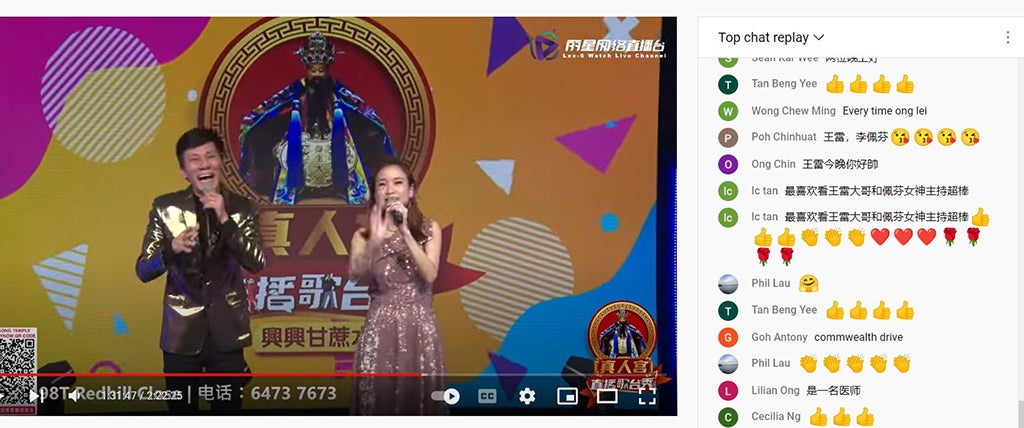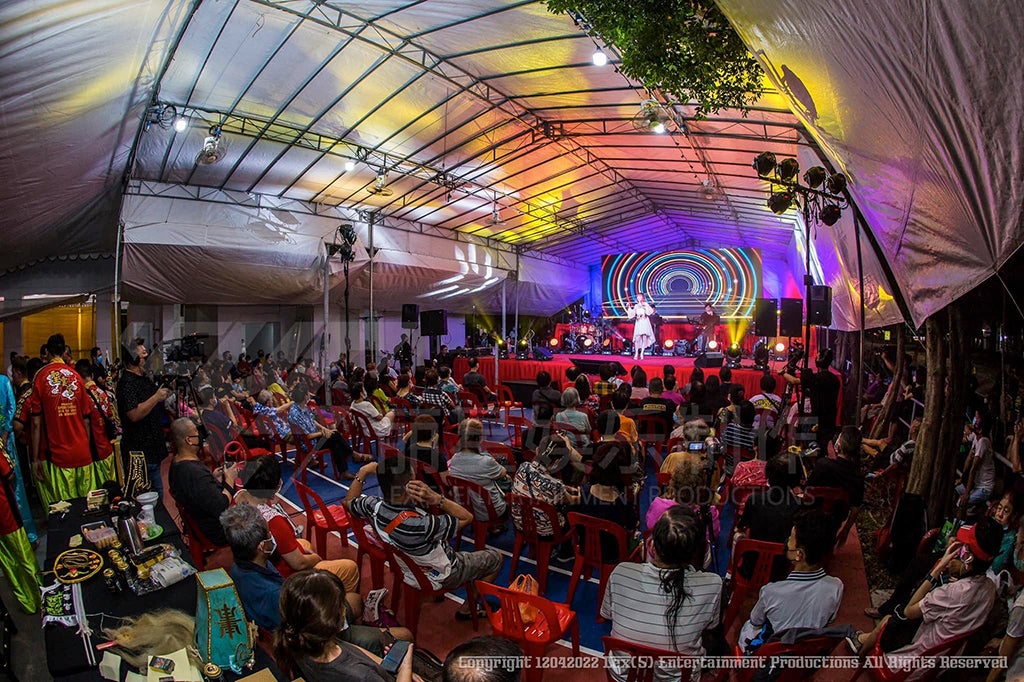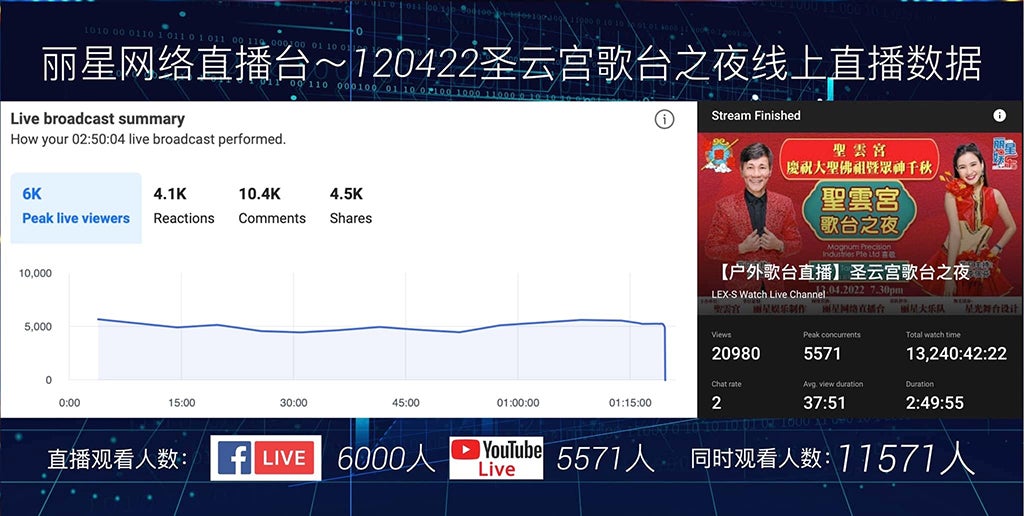Join from Home –Three Scenarios of Singaporean Chinese Temples in the Time of COVID
contributed by Wu Qi, 15 June 2022
The COVID-19 pandemic has forced religious organisations to shut down during the circuit breaker and to limit the number of visitors as the new norm. Different religious organisations are responding to COVID in their own ways, due to the earlier restrictions before the major easing of Covid-19 rules from Apr 26, 2022.
Talk to the Deity through Zoom
Mr. R, an active member of the local Dejiaohui (Moral Uplifting Society德教会) congregation, has three zoom sessions to attend on Saturday. The first one is a moral teaching class delivered by a famous mentor from Malaysia. The second one is a chanting session where Dejiaohui members from different regions could chant the Dejiaohui classic, Xin Dian心典, together. The third one is a spirit-writing session delivered by the spirit-writing group of a Dejiaohui congregation in Australia.
Dejiaohui has built their cross-regional network for decades. Before the pandemic, cross-regional activities of various forms were held frequently, especially after the 1990s. But due to the pandemic, cross-border visits are difficult to achieve. In the beginning, they just used WhatsApp groups on their mobiles for simple text communication, which might include exchanges of pictures and videos. As computer interface platforms such as Zoom or MS Teams were gradually introduced and promoted in the workplace during the work-from-home period, the public started to master those tools. Larger electronic screens compared to mobile phones also offer the possibility of displaying more detailed and multimedia contents.
The moral teaching and learning sessions are essential for active members. The need for spiritual guidance is even greater during the pandemic.
Through sharing sessions, participants can interact with each other. Their relationship and even the sense of community can be strengthened and enhanced without a real face-to-face meeting.
During the pandemic, due to safe distancing and other restrictions, local congregations in Singapore could not continue their spirit-writing. However, Dejiaohui puts great importance on spirit-writing. It is their main way of communicating with the gods and deities. Worshippers could ask questions relating their personal lives as well as congregation development and management issues through spirit-writing. Through Zoom, they can interact with spirit writers in other countries and communicate with the gods and deities. Alvin Lim examined the phenomenon of Chinese underworld gods and spirit mediums engaging with online devotees through live-streaming during the COVID-19 pandemic. He stated that all those emergent practices compelled him to consider the broader implications of the digital medium’s blurring of the spiritual and the somatic, real and imagined, presence and absence, material and abstract. In the case of Dejiaohui, we also have to think about how they redefine, reimagine and remake the digital space, between spiritual and physical, material and abstract.
Besides, the arrangement of those Zoom sessions reflects the flexibility of Dejiaohui’s transnational network in the pandemic period. Thanks to the help of those online tools, congregations in different regions can exchange and share resources, and solve problems through the trans-regional network without any physical movement. Moreover, their sense of community is more likely to be reinforced in difficult times.
Getai into Digital Live-Stream Era
Before the pandemic, Chinese temples usually celebrated the birthday of their main deity with a series of celebration activities, including banquets and getai (getai 歌台 is a form of vernacular entertainment involving live performances of music, song, and dance, usually held during festive occasions.)performances. Worshippers and supporters would be invited to join the celebration. And they call it the “Big Day”. In addition, the Hungry Ghost Festival, Mid-Autumn Festival, Lunar New Year and so on are also big days for different Chinese temples, depending on their characteristics and customs. Usually, a temple has one or two big ceremonies every year.
The Corona virus changed people’s daily lives as well as their religious practices. Due to the pandemic, temples were unable to hold their usual celebrations. However, some temples still offered live getai shows to worshippers and the public. But this time it is online.

Figure 1. Coverpage of “Singapore Getai” Facebook account posted on 13/12/2021. It states that getai is going “Into Digital Live Stream Era”. (Screengrab by the author on 1 May 2022)
Lex(S) Entertainment Production, one of the leading companies of the local getai industry, provides total solutions for getai shows, including lighting, laser effects, sound systems, talents of different varieties, and so on. Before the pandemic, they were also able to provide live streaming services. But most were just extensions of outdoor getai performances. During the pandemic, they were forced to focus more on streaming live performances online. These performances normally take place in a studio without any audience. And audiences can enjoy the show at home through Facebook or YouTube.

Figure 2. A poster of an online getai live show posted by LEX-S Watch Live Channel on 16/11/2021. Zhen Ren Gong Temple celebrated the gods' birthday and their 109th anniversary with an online getai live show produced by Lex(S). QR codes linking to Lex(s)’s Facebook page and YouTube channel were provided on the poster. (From LEX-S Watch Live Channel Facebook account, accessed 1 May 2022)
Temples and production companies advertise the shows ahead of time on platforms they normally use to communicate information with worshippers and supporters, such as their Facebook page and WhatsApp groups.
While enjoying the live performance, audiences could post text comments and emojis at the same time.
Those live broadcasts are not only available on the day itself, but are also available anytime in the virtual space following the first live screening.
In this way, audiences can communicate across time. Their comments will be accumulated continually with those videos. Anyone can share it to other platforms with a link by a simple click. Thus, those performances could be shared across different platforms. Someone might share it with a newly created hashtag. In the process, all the viewers, commenters and retweets reproduced this event. Even those who keep a low profile and aren’t internet savvy can play a part in the reproduction through a simple “like” click.

Figure 3. Screenshot of Zhen Ren Gong online getai live show with audiences’ comments in the chat box. (Screengrab by the author from Lex(s) YouTube channel on 1 May 2022)
Further investigation is required to determine whether the circulation is confined within the temple community or has reached a broader public domain.
Those online activities successfully created connections between supporters and temples. It maintains and strengthens their relationship at a time when it is not safe or convenient to visit the temple because of the pandemic.
About 15% of the audience were watching Lex(S)’s online getai show from overseas countries and cities, mostly from Malaysia and a few from Australia, Switzerland, the United States, Thailand, Hong Kong, Macau and Taiwan. Moreover, Lex(S) cooperated with another studio in Malaysia to carry out an online getai relay show (A relay show is a show delivered jointly by two production teams in different studios. The first team runs the first half of the whole show from their own studio and the second team takes over the broadcasting space later from another studio). Online getai has an advantage on cross-regional resource sharing. Communication across domains becomes easier and cheaper.
However, there is a big gap between the live and online viewing experience. Without the surrounding shouts, voices of others and curious passers-by stopping to watch, the whole atmosphere and experience differs to a large extent. A lively atmosphere is essential for traditional Chinese religious celebrations. Adam Chau (2008) pointed out that temple festivals are “hot and noisy” folk event productions replete with noises, sights, smells, tastes, and ambient sensations. The same goes for getai performances. Adam Chau used the concept of honghuo(social heat or red-hot sociality) to describe the whole production and experience. He also pointed out the importance of the sensorial production of sociality in those events. The social heat is essential for getai performances.
Furthermore, with close-up shots in the studio, artists are under more pressure to perform as they tend to be more professional and less casual. However, a distinguished feature of getai is the casual interaction between artists and audiences with comedic banter, humoured commentary, jokes and puns.
Starting March 29 2022, there is no capacity limit for events with ≤1,000 participants at a time. From 26 April 2022, group size limits, event capacity limits and safe distancing requirements were removed in Singapore. With restrictions now beginning to ease, outdoor getai is resuming. On the evening of 12 April 2022,Sheng Yun Temple’s gods birthday celebration getai show was held outdoor in Tampines. This is the first outdoor getai show that Lex-S produced after the easing of community Safe Management Measures. And the show was also broadcast live through network platforms.

Figure 4. Photo of the Sheng Yun Temple’s gods birthday celebration outdoor getai show held on 12 April 2022. (From Lex-S Watch Live Channel Facebook Page, accessed 25 May 2022)

Figure 5. This Sheng Yun Temple’s gods birthday celebration outdoor getai show was also broadcast live online. (From Lex-S Watch Live Channel Facebook Page, accessed 25 May 2022)
“Die Die” Must Pray Tai Sui
It is a tradition to pray Tai Sui for protection and peace at the beginning of the Chinese New Year. In Chinese astrology, Tai Sui means the Guardian God of the lunar year. Tai Sui god governs your fortune in a year. There are 60 Tai Sui gods, each in charge of a particular year. They take turns for their governing duty.
Mr L. who was born in the year of the tiger, and his father who was born in the year of the monkey, both conflict with Tai Sui this year. This is determined by their zodiac signs. Thus they “die die” must pray Tai Sui (Die Die Must Do Something is a phrase commonly used in Singapore to express that someone has to do something, no matter what!). Normally, they would go to the temple and pray. However, as his father is in poor health, they tend to protect themselves by acting more carefully during the pandemic and avoid gathering in crowded places. They chose not to go to the temple. Instead, Mr L. contacted a local Chinese temple which was offering extra service for those who cannot visit the temple personally. He saw the poster on the temple’s Facebook page, contacted the temple through WhatsApp, and made his payment by PayLah. He gave the temple their names, and dates of birth. On the other side, the temple wrote their names on a memorial to heaven, completed the prayer ritual, burnt the memorial and other paper tributes. With this extra service, Mr. L. could complete the pray Tai Sui ritual from home.
Since the pandemic outbreak, many people have not been able to access religious services as it is not convenient to go to the temple. Some temples have developed and made good use of online tools to reach their supporters and even the public domain. The most used platforms for local Chinese temples are Facebook, WhatsApp and Zoom. Some leading ones have developed their own Apps. For example, one of the most popular local Taoist temples, Koo Chye Sheng Hong Temple, developed its own App, prior to the pandemic, four years ago. The pandemic has pushed this digital development further. Koo Chye Sheng Hong Temple’s Online Devotees Service System was launched on 5th July 2020. This system provides services such as online donations, lighting of blessing lamps, registration for celebrations, blessing prayers and other religious services. Devotees need not visit the temple personally. They could access the online system and religious services with simple clicks.

Figure 6. Screenshots of Koo Chye Sheng Hong Temple App. (Screengrab by the author from iPhone on 25 April 2022)
However, some other temples are still reluctant to implement this “pray-from-home” mode. They still insist that worshippers have to come into the temple, hold the joss sticks, and stand in front of the altar to pray. They believe that this is the only sacred way to receive blessings. Another group feels that simple general practices such as Pray Tai Sui could be done from home with the help of temple staff. But more complicated religious services and rituals require the physical presence of the person in the temple.
This is a new question about whether worship from home is effectively devout and sacred. During my fieldwork from September 2021 to the present (May 2022), I have spoken to more than 50 leaders of different local Chinese religious organizations about their development in COVID-19 era. It shows that religious leaders have different views over this question.
On the other hand, this pray-from-home mode makes religious services more convenient and accessible than it was before the pandemic. But some worshippers also feel that it is more “authentic” to stand in front of the altar, hold the joss sticks in a smoky atmosphere and talk to the gods “face-to-face”. Others feel that new modalities of prayer can only be a compromise during the pandemic. Opinions over this question vary.
Discussion
Since the outbreak of the pandemic, there have been many stories about religion and online interfaces in Singapore. Worshippers can donate and pray for blessings easily through their mobile phones without physically moving to temples. They can participate in daily religious gatherings with gods or other believers at home, or attend grand religious celebrations, learn from religious texts, or seek divine protection from home.
From the above stories, we can see that religious services and operations are classified into different levels by their complexity and significance. People are more comfortable with using online tools for basic and general practices.
If we look closer at the connection between religion and the digital world during the COVID-19 pandemic, we’ll see that most of the time the digital world is still an extension of the physical world rather than a replacement of it. You can use online applications to communicate, to order, to broadcast, to receive religious practices. However, all the operations, rituals, performances have to be performed in actual physical spaces. For the case of Chinese temples, a complete virtual model may still remain the subject of the future.
The mode of join-from-home still has some drawbacks, including the lack of smell, touch, the absence of others, and the relatively dull and quiet atmosphere. In addition, physical materials cannot be delivered online. Up to now, no charms or any other fortune goods have been delivered in digital forms in any local Chinese temples.
For a long time, Chinese religious groups have not shown much motivation for technological and digital progress. Most worshippers are elderly people and less internet savvy. The pandemic is such a powerful catalyst that many organizations have been forced to incorporate online tools. During the process of adapting to the digital world, some religious leaders and believers are beginning to appreciate the convenience of such tools. This global health crisis has shaped the operation of local Chinese religious groups. Their tradition is changing. And there is a strong tendency for these changes to continue beyond the end of the epidemic.
At the same time, this attitude of seeking new ways within the limits of pre-existing regulations shows the flexibility of Chinese folk religion. Many Chinese religious groups have gone through major challenges and crises in different eras, they showed strong vitality.
As for the question whether the introduction of virtual and digital space will confuse the authenticity of faith and rituals, we may search the answer in the ancient classics of Buddhism and Taoism.
One of the most influential texts of the Buddhist canon, the Diamond Sutra, says that: “All conditioned phenomena are like dreams and illusions, are like dew and lightning flash. That is the proper way to perceive them 一切有为法,如梦幻泡影,如露亦如电,应作如是观.”
Zhuangzi, one of the greatest ancient Chinese Daoist philosophers, once dreamed he was a butterfly. But then he did not know whether he was Zhuang Zhou dreaming he was a butterfly or a butterfly dreaming he was Zhuang Zhou. The reality and the dream could not be distinguished.
Those classics show that the boundary between reality and illusion is blurry, and the key is how we negotiate it. Ancient Chinese philosophers have even asked whether the world we live in is a reality or an illusion. In the digital age, the development of Chinese temples will take on new changes. The pandemic has only accelerated the process. As changes are unfolding, the vital question is whether worshippers and temple leaders are willing to reimagine and reconstruct the online religious space. Either way, “join from home” scenarios will become the community’s collective memory and offer new options and possibilities for future religious development.
Disclaimer: The views and opinions expressed in this article are those of the authors and do not necessarily reflect the position of the blog editorial team or the Asia Research Institute.
South Asia | Southeast Asia | East Asia | Other Places | Hinduism | Buddhism | Islam | Christianity | Other Religions
Dr. Wu Qi is Research Fellow at Asia Research Institute. Her research focuses on overseas Chinese society and Chinese religion. She is particularly interested in the transregional network of Chinese religious and charity organisations. Her dissertation has been accepted for publication.

